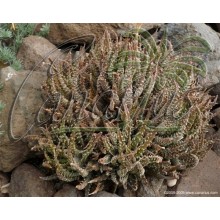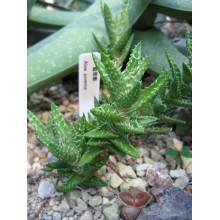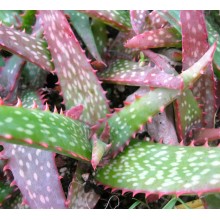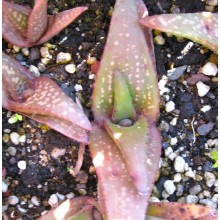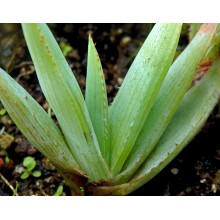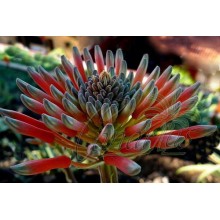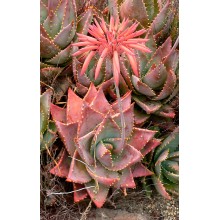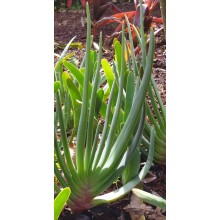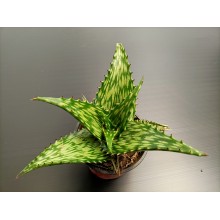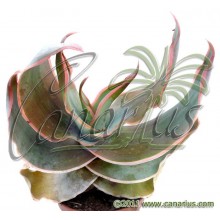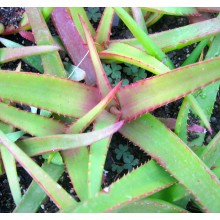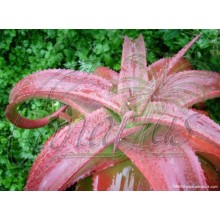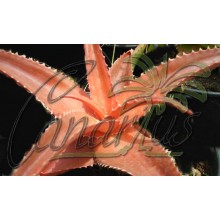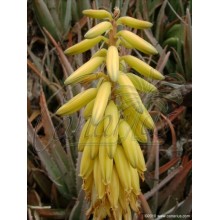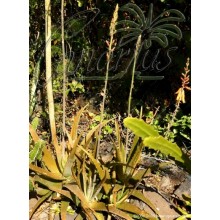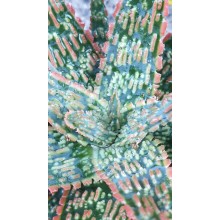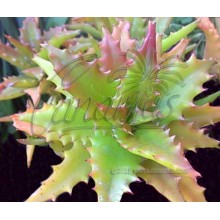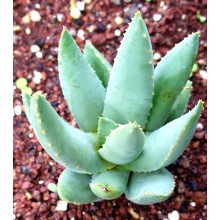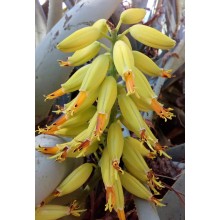Succulente Ci sono 628 prodotti.

I deserti del mondo e le zone secche ospitano le piante più interessanti. Canarius offre una selezione crescente di piante succulente di massima qualità, perché sono coltivate all'aperto, in pieno sole delle Isole Canarie.
I succulente o "piante grasse" sono specie di ritenzione di acqua, adattate alle condizioni di asciutto. Loro accumulano succum (succo, acqua) nelle loro foglie, steli o radici, e spesso mostrano un aspetto robusto e carnoso.
Sotto-categorie
-
Agave
Agave è un genere di piante grasse provenienti dall'America. Alcune specie crescono in zone fredde e possono sopportare un forte gelo, mentre altri vivono in climi tropicali. Alcuni sono piccoli nani e alcuni sono giganti, fino a 2 o 3 m di larghezza.
Le agavi resistenti al freddo possono creare un effetto esotico nel vostro giardino. Le specie agave fanno bella compagna di palme o cactus. Le agavi variegate sono incredibilmente ricercati dai collezionisti. Il nostro negozio web offre una selezione in continua evoluzione delle specie. Spediamo piante a radice nuda, se non diversamente specificato.
-
Aloe, Gasteria & Haworthia
Aloe, Gasteria e Haworthia sono tre generi correlate, comprese centinaia di piante succulente. Sono tutti facilmente coltivate in vaso. Alcuni si adattano a bassi livelli di luce di condizioni interne e possono essere coltivate come piante da appartamento.
- Aloe è un genere di circa 400 specie, originarie di Africa, Arabia e Madagascar. I aloe piccoli o nani stanno diventando particolarmente popolare in climi più freddi in quanto possono essere presi in casa durante i mesi più duri.
- Gasteria comprende circa 80 specie endemiche in Sud Africa, conosciuti per le loro foglie spettacolari che sono lucide, screziati e ruvidi. Fioriscono in primavera-estate con lunghe punte di piccoli fiori arancioni. Alcune specie sono talmente variabile che offriamo cloni particolari di località specifiche.
- Haworthia è un genere endemico in Sud Africa con circa 70 specie e un certo numero di sottospecie locali, varietà e forme. Le foglie sono spesso banded, punteggiati, punteggiato, o semi-trasparente e mostrano ampie variazioni.
-
Crassule
Questa è una nuova e crescente sezione di specie della famiglia Crassulaceae. Ci sono circa 1.400 specie in 33 generi et la loro distribuzione è in tutto il mondo, ma si presentano più nell'emisfero Nord e Sud Africa, in particolare in ambienti asciutti. Qui si possono acquistare piante sani, indurito dal sole, coltivati nelle isole Canarie e spediti a casa tua.
-
Mesembriantemi
Questo gruppo di piante del deserto è chiamato Mesembriantemi perché appartengono a una famiglia botanica precedentemente denominata Mesembryanthemaceae. Ci sono quasi 2.000 specie, che si trovano principalmente in Africa del sud, con adattamenti estremi agli habitat secco. Alcuni sono chiamati "pietre vive", perché sembrano come ciottoli. Molti sono facili da coltivare e il loro bisogno principale è pieno sole. Alcuni sono difficili perché crescono nelle aree veramente estreme.
Il nostro Web Shop offriamo piante sane coltivate al sole, con foglie compatte e colorate. Alcune piante sono venduti come talee, e altri come piante radicate, di almeno due anni. -
Sansevieria
Recentemente assegnato alla famiglia Asparagaceae, il genere Sansevieria conta circa 70 specie, quasi tutti nativi in Africa, Arabia e Madagascar. Erbe perenni adatti per gli habitat secchi con foglie rigide, succulente, la loro lunghezza varia da pochi centimetri a 2 metri. Sansevieria trifasciata e le sue numerose cultivar sono tra le piante d'appartamento più apprezzati, popolarmente chiamata la lingua di suocera. Una pianta ben coltivata di solito produce un picco di molti fiori bianchi, riccamente profumati e poi bacche arancioni. Anche le specie più rare sono resistenti ad abbandono, a condizione di tenerli dal gelo in inverno e sole cocente in estate.
-
Hoya
Le Hoyas sono rampicanti, dai fiori esotici e spesso vistosi. Provengono dalle foreste pluviali in Asia e Oceania. La maggior parte delle specie vive bene a mezz' ombra e si adatanno a vivere in casa come piante da appartamento. Sono ideali per cesti e tralicci. Tollerano un paio di settimane di siccità, ma sono sensibili al gelo e freddo. Molte hoya i sono facili da far crescere e fiorire, mentre alcune sono difficili e rare.
-
Asclepiadaceae
Le Asclepiade, o Asclepiadoideae, sono una sottofamiglia delle Apocynaceae, che annoverano circa 2900 specie diverse. Tra queste si trovano molti fusti privi di foglie ma anche erbe perenni, arbsuti, liane e, raramente, alberi. Producono fiori molto belli, dato il complesso sistema di impollinazione. Molte specie producono un odore insolito, spesso associato a quello di una carogna, la cui funzione è quella di attrarre le mosche che poi andranno a impollinare i fiori. -
Caudiciformi
Queste piante, dette anche pachicauli, sono tipiche delle zone aride. Producono un tronco insolitamente grosso e sproporzionato, detto caudice (a volte anche tubero), spesso con ramificazioni. Il caudice può essere anche nascosto sottoterra, ma nella maggior parte dei casi ha sviluppo verso l'alto, dando luogo ad alberi dalla forma spettacolare. I caudiciformi più grandi sono i baobab. -
Altre succulente
Qui troverete tutte quelle specie di piante del deserto che non sono inclusi nella propria categoria. Metteremo qui tutte le piante provenienti da famiglie inusuali, diversi da Agavi, Aloe, Crassulaceae, Sansevieria, Mesembriantemi, Epiphytic cacti, etc.
-
Aloe juvenna
Aloe juvenna
Cont. 8 cm. It is native to South Africa and its grows vertically and grouped.Its leaves from green spiral rosettes whith specks and small spines.
10,20 € -
Aloe labworana
Aloe labworana
Stemless aloe with yellow flowers, native to rocky outcrops in the mountains of northern Uganda and southern South Sudan between 1300 and 1500 m.
23,20 € -
Aloe lavranosii
Aloe lavranosii
Aloe lavranosii is a native of Yemen on the Arabian Peninsula. It is one of the few species of Aloe with "hairy" flowers. Plants grow usually solitary with blueish leaves.
14,20 € -
Aloe lineata
Aloe lineata
South African species with blue-green leaves marked with longitudinal red lines (hence "lineata"). It branch from the base and produces erect stems, so it eventually becomes a dome-shaped shrub, 1-2 m tall.
13,40 € -
Aloe maculata
Aloe maculata
10 cm cutting. Slowly clumping rosette,with elegant red inflorescences held on tall stalks. The dark green leaves have the typical white H spots.It is a widespread South African aloe tolerant of different conditions.
10,80 € -
Aloe perfoliata
Aloe perfoliata
Cont. 8 cm. It is native to South Africa and its characterized by prostrate, long and branching stems that isn't stend of growing upright but they tend to sprawl along the ground and over rocks.
11,70 € -
Aloe plicatilis (Kumara plicatilis)
Aloe plicatilis (Kumara plicatilis)
Thick 15-20 cm 1-y old rooted plant - It is a spectacular species, relative of the genus Aloe with leaves arranged as fans. Kumara plicatilis grows as a shrub or small tree and thrives outdoors in the coastal Mediterranean. It blooms in winter and its flowers are much larger than most aloes !
45,00 € -
Aloe plicatilis (Kumara plicatilis)-Large
Aloe plicatilis (Kumara plicatilis)-Large
Thick 26-40 cm 2-y old rooted plant - It is a spectacular species, relative of the genus Aloe with leaves arranged as fans. Kumara plicatilis grows as a shrub or small tree and thrives outdoors in the coastal Mediterranean. It blooms in winter and its flowers are much larger than most aloes !
60,60 € -
Aloe somaliensis
Aloe somaliensis
Elegant spotted aloe from Somalia. The glossy rosettes are often solitary, low growing. Colours change through the seasons, from green to grey, copper, burgundy or brown.
18,20 € -
Aloe striata
Aloe striata
Cont.= 12 cm. Larger specimen. - Very ornamental South African species, with a compact rosette of colourful, smooth leaves with beautiful red inflorescences.
14,30 € -
Aloe tauri
Aloe tauri
This hard to find species is very attractive due to its bright orange blush, promoted by full sun and cooler nights. It grows on the southern escarpment in Zimbabwe, at 1000-120 exposed to SE winds and mist. It is promisingly cool-resistant and it thrives outdoors in coastal mediterranean conditions.
26,50 € -
Aloe vanbalenii
Aloe vanbalenii
Very elegant, large South African Aloe with a stemless spreading rosette of colourful recurved leaves. Leaves can get a different colour according to light intensity, yellow-green to orange and eventually rusty-red in full sun. Rosettes can get up to 1 m large and slowly grow into clumps. Flower spike are also attractive, with yellow flowers.
23,10 € -
Aloe vaombe
Aloe vaombe
Impressive large and colourful Aloe from Southern Madagascar. Leaves are green during the growing season and turn red during rest. It grows outdoors in warm Mediterranean conditions but can be damaged by frost.
15,48 € 17,20 € -
Aloe vera - 1 kg Large Plant
Aloe vera - 1 kg Large Plant
Robust plant, 30-40 cm, 1 kg, field-grown in full sun. This is the famous Aloe vera, known for holding healthy properties. The tips of the tall flower spikes are edible. Leaves are green-glaucous to pink-copper. Takes light frost if kept dry.
11,80 € -
Aloe vera var. chinensis
Aloe vera var. chinensis
10 cm cutting. A different, red flowered Aloe vera. This variety is slower than the typical form and has a denser, richer sap, also used in traditional medicine.
14,20 € -
Aloe x 'Christmas Carol' - Large
Aloe x 'Christmas Carol' - Large
This hybrid Aloe is a winner! It is a great beauty, with all types of reds, green and purples displayed on stripes, dots and teeth. 'Christmas Carol' is mid-sized and can reach 30 cm in diameter and height. It was developed by Griffin, the famous hybridiser of small sized aloes.
35,00 € -
Aloe x buettneri
Aloe x buettneri
Rooted plant, 10-12 cm diam. Cont. 8 cm. We got this Aloe as A. buettneri, but it looks to us like a hybrid of Aloe dorotheae. Rosettes are 10-16 cm wide, leaves are speckled and turn glossy red during rest or in full sun. It grows as a dense groundcover and makes a nice potted specimen or even a hanging basket plant. It can stand low temperatures but it...
14,20 € -
Aloidendron dichotomum 'Namibia'
Aloidendron dichotomum 'Namibia'
Aloidendron dichotomum is one of the most beautiful of the tree-aloes. has a very wide distribution of hundred of kilometers spanning from Namibia to RSA.
25,30 € -
Aloidendron dichotomum - RSA
Aloidendron dichotomum - RSA
One of the most exotic of all desert trees: this tree aloe stands out in dry areas of Namibia and South Africa. Throughout much of its range this species is in decline.
12,40 €
Al momento ci sono pochi prodotti in questa categoria Succulente

























